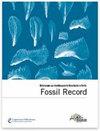首次在泰国发现Duboisia(牛科,偶蹄目,哺乳纲)
IF 2.1
4区 地球科学
Q1 PALEONTOLOGY
引用次数: 5
摘要
摘要来自泰国的Duboisia(Boselaphini,Bovidae)的第一个化石记录证实,该属不再是印度尼西亚爪哇岛的特有种。新的化石材料是从泰国东北部呵叻府Tha Chang的一个沙坑中采集的一个带有角核的头骨(早于中更新世)。目前的标本暂时被分配到一个种Duboisia aff。D.三藤,其角核上的前脊和前龙骨比D。爪哇早更新世和中更新世沉积物中的三藤,但这些物种具有角核的基本特征:下部向后倾斜;上半部向上弯曲;横截面圆形三角形,前后压缩,具有内侧和外侧龙骨。D.aff之间的形态学相似性。santeng和D.santeng支持中更新世前东南亚大陆和爪哇岛之间强烈的动物区系交流,并认为Duoisia属与“湿婆-马来亚”地区的其他Boselaphini属分化。本文章由计算机程序翻译,如有差异,请以英文原文为准。
First occurrence of Duboisia (Bovidae, Artiodactyla, Mammalia) from Thailand
Abstract. The first fossil record of Duboisia (Boselaphini, Bovidae) from
Thailand confirms that this genus is no longer endemic to Java, Indonesia.
The new fossil material is a calvarium with horn cores (older than the Middle
Pleistocene) collected from a sandpit at Tha Chang, Nakhon Ratchasima
Province, north-eastern Thailand. The present specimen is provisionally
allocated to a species of Duboisia aff. D. santeng, which
has weaker precornual ridges and anterior keels on the horn cores than
D. santeng from Early and Middle Pleistocene deposits of Java, but
these species share basic characteristics of horn cores as follows: the lower
half inclined backwards; the upper half curved upwards; cross section rounded
triangular, antero-posteriorly compressed, and with medial and lateral keels.
Morphological similarities between D. aff. santeng and D. santeng support a strong faunal interchange between continental South East Asia
and Java before the Middle Pleistocene, and suggest that the genus
Duboisia diverged from the other genera of Boselaphini in the
“Siva-Malayan” region.
求助全文
通过发布文献求助,成功后即可免费获取论文全文。
去求助
来源期刊

Fossil Record
PALEONTOLOGY-
CiteScore
3.60
自引率
7.10%
发文量
18
审稿时长
14 weeks
期刊介绍:
Fossil Record (FR) is the palaeontological journal of the Museum für Naturkunde Berlin. This journal was founded in 1998 under the name Mitteilungen aus dem Museum für Naturkunde Berlin, Geowissenschaftliche Reihe and appears with two issues each year. Fossil Record publishes original papers in all areas of palaeontology including the taxonomy and systematics of fossil organisms, biostratigraphy, palaeoecology, and evolution. All taxonomic groups are treated, including invertebrates, microfossils, plants, and vertebrates.
 求助内容:
求助内容: 应助结果提醒方式:
应助结果提醒方式:


